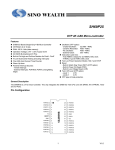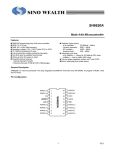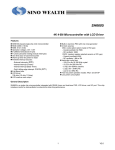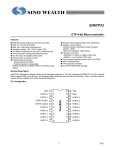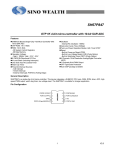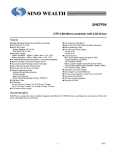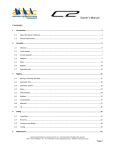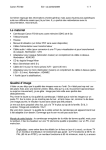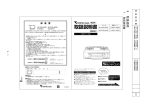Download SH69P23 - SinoWealth!
Transcript
SH69P23 PRELIMINARY OTP 4-bit Microcontroller Features SH6610C-based single-chip 4-bit micro-controller OTPROM: 4K X 16 bits RAM: 160 X 4 bits (data memory) Operation voltage: 2.4V - 6.0V (typical 3.0V or 5.0V) 14 CMOS bi-directional I/O pins Built in pull-up and pull-low resistor for PortA ~ PortF 4-level subroutine nesting (including interrupts) One 8-bit auto re-load timer/counter Warm-up timer for power on reset Powerful interrupt sources: - Internal interrupt (Timer0) - External interrupts: PortB & PortC (rising/falling edge) Oscillator (OTP option) - X`tal oscillator: 32.768KHz - 4MHz - Ceramic resonator: 400K - 4MHz - RC oscillator: 400K - 4MHz - External clock: 30K - 4MHz Instruction cycle time: - 4/32.768KHz(122us) for 32.768KHz OSC clock - 4/4MHz (1us) for 4MHz OSC clock Two low power operation modes: HALT and STOP Built-in watch dog timer (OTP option) Built-in power on reset Two LPD level(OTP option) - High level: 4.0V - Low level: 2.5V OTP type &Code protection General Description SH69P23 is a 4-bit micro controller. This chip integrates the SH6610C 4-bit CPU core with SRAM, 4K OTPROM, Timer and I/O Ports. Pin Configuration 1 20 PF0 2 19 PA1 PA3 3 18 PA0 / SDA T0 4 17 OSCI / SCK RESET/ VPP 5 16 OSCO 15 VDD 14 PC3 13 PC2 SH69P23 PF1 PA2 GND 6 PB0 7 PB1 8 PB2 9 12 PC1 PB3 10 11 PC0 1 V1.0 SH69P23 Block Diagram RESET OSCO OSCI OSC WDTEN CPU RC RESET WATCHDOG TIMER PRESCLALER PORTA ( 4-BITS ) PORTA [0:3] Power on PORTB ( 4-BITS ) PORTB [0:3] LPD PORTC ( 4-BITS ) CTL REG. PORTC [0:3] LPDON T0 8-BITS TIMER ( Up counter ) TIMER INTERRUPT PORTD (4-BITS ) OTPROM 4096*16 BITS PORTF [0:1] DATA RAM 160*4 BITS 2 SH69P23 Pin Description(Normail mode) Pin No. Designation I/O Descriptions 20, 1 PF[0:1] I/O Bit programmable I/O 18,19, 2, 3 PA[0:3] I/O Bit programmable I/O. 4 T0 I Timer Clock/Counter input pin. (Schmitt trigger input) 5 RESET I Reset input (active low, Schmitt trigger input). 6 GND P Ground pin 7 - 10 PB[0:3] I/O Bit programmable I/O. Vector Interrupt (Active rising or falling edge by system register setup) 11 - 14 PC[0:3] I/O Bit programmable I/O. Vector Interrupt (Active rising or falling edge by system register setup) 15 VDD P Power supply pin 16 OSCO O OSC output pin. No output for RC mode 17 OSCI I OSC input pin, connected to a crystal, ceramic or external resistor. Pin Description(OTP program mode) Pin No. Symbol I/O Shared by Description 15 VDD P VDD 5 VPP I RESET 6 GND P GND Ground 17 SCK I OSCI Programming Clock input pin 18 SDA I/O PA[0] Programming Data pin Power supply (+5.5V) High voltage Power supply (+10.5V) * When the chip is being programmed, the VDD VPP SCK SDA should be separated from other appliction circuits . 3 SH69P23 Function Description 1. CPU The CPU contains the following function blocks: Program Counter, Arithmetic Logic Unit (ALU), Carry Flag, Accumulator, Table Branch Register, Data Pointer (INX, DPH, DPM, and DPL), and the Stack. Decision (BA0, BA1, BA2, BA3, BAZ, BAC) Logic Shift (SHR) The Carry Flag (CY) holds the ALU overflow which the arithmetic operation generates. During an interrupt servicing or call instruction, the carry flag is pushed into the stack and retrieved back from the stack by the RTNI instruction. It is unaffected by the RTNW instruction. 1.1. PC (Program Counter) The Program Counter is used to address the 4K program ROM. It consists of 12-bits: the Page Register (PC11), and the Ripple Carry Counter (PC10, PC9, PC8, PC7, PC6, PC5, PC4, PC3, PC2, PC1, PC0). The program counter normally increases by one (+1) with every execution of an instruction except in the following cases: (1) When executing a jump instruction (such as JMP, BA0, BAC), (2) When executing a subroutine call instruction (CALL), (3) When an interrupt occurs, (4) When the chip is in the INITIAL RESET mode. The program counter is loaded with data corresponding to each instruction. The unconditional jump instruction (JMP) can be set at 1-bit page register for higher than 2K. 1.3. Accumulator The Accumulator is a 4-bit register holding the results of the arithmetic logic unit. In conjunction with the ALU, data transfer between the accumulator and system register or data memory can be performed. 1.4. Stack A group of registers are used to save the contents of CY & PC (10-0) sequentially with each subroutine call or interrupt. It is organized into 13 bits X 4 levels. The MSB is saved for CY. 4 levels are the maximum allowed for subroutine calls and interrupts. The contents of the Stack are returned sequentially to the PC with the return instructions (RTNI/RTNW). The stack is operated on a first-in, last-out basis. This 4-level nesting includes both subroutine calls and interrupts requests. Note that program execution may enter an abnormal state if the number of calls and interrupt requests exceed 4, and the bottom of the stack will be shifted out. 1.2. ALU and CY ALU performs arithmetic and logic operations. The ALU provides the following functions: Binary addition/subtraction (ADC, SBC, ADD, SUB, ADI, SBI) Decimal adjustment for addition/subtraction (DAA, DAS) Logic operations (AND, EOR, OR, ANDIM, EORIM, ORIM) 2. OTPROM The SH69P23 can address up to 4096 X 16 bit words of program area from $000 to $FFF. Service routine as starting vector address. Address Instruction $000H JMP Instruction $001H NOP $002H JMP Instruction $003H NOP $004H JMP Instruction Remarks Jump to RESET service routine Reserved Jump to TIMER0 service routine Reserved Jump to PBC service routine 4 SH69P23 3. RAM The built-in RAM consists of general-purpose data memory and the system register. Direct addressing in one instruction can access both data memory and the system register. The following is the memory allocation map: $000 - $01F: System register and I/O. $020 - $0BF: Data memory (160 X 4 bits, divided into 2 banks. $020 - $07F: bank0, $080 - $0BF: bank1). (a). The Configuration of the System Register Address Bit3 Bit2 $00 - IET0 $01 - IRQT0 $02 - TM0.2 $03 - - Bit1 Bit0 R/W Remarks - IEP R/W Interrupt enable flags - IRQP R/W Interrupt request flags TM0.1 TM0.0 R/W - - - Timer0 Mode register (Prescaler) Reserved $04 TL0.3 TL0.2 TL0.1 TL0.0 R/W Timer0 load/counter register low digit $05 TH0.3 TH0.2 TH0.1 TH0.0 R/W Timer0 load/counter register high digit $06-$07 - - - - - $08 PA.3 PA.2 PA.1 PA.0 R/W Reserved PORTA $09 PB.3 PB.2 PB.1 PB.0 R/W PORTB $0A PC.3 PC.2 PC.1 PC.0 R/W PORTC Bit0-3 is reserved,Always keep it to “0” in the User’s program. Refer to I/O notice $0B~$0C $0D - - PF.1 PF.0 R/W PORTF $0E TBR.3 TBR.2 TBR.1 TBR.0 R/W Table Branch Register $0F INX.3 INX.2 INX.1 INX.0 R/W Pseudo index register $10 DPL.3 DPL.2 DPL.1 DPL.0 R/W Data pointer for INX low nibble $11 - DPM.2 DPM.1 DPM.0 R/W Data pointer for INX middle nibble DPH.2 DPH.1 DPH.0 R/W Data pointer for INX high nibble Reserved Bit1:PBC interrupt rising / failing edge set PH/PL PBCFR - R/W Bit2:Port pull-hi/low set $12 $13 - $14 $15 PULLEN Bit3: Port pull-up/low enable control $16 PA3OUT PA2OUT PA1OUT PA0OUT R/W PortA input/output control 0: input 1: output $17 PB3OUT PB2OUT PB1OUT PB0OUT R/W PortB input/output control 0: input 1: output $18 PC3OUT PC2OUT PC1OUT PC0OUT R/W PortC input/output control 0: input 1: output Bit0-3 is reserved,Always keep it to “1” in the User’s program. Refer to I/O notice $19~$1A $1B - - PF1OUT PF0OUT R/W $1C - - T0S T0E $1D - - - - - $1E WDT - - - W $1F - - - - - PortF input/output control 0: input Bit0: T0 signal edge; Bit1: T0 signal source R/W 1: output Reserved Bit3: WDT timer reset (write 1 to reset WDT) Reserved * System Register $00 - $12 (except $07H) refer to "SH6610C User manual". 5 SH69P23 (b) System Register state: Power On Reset /Pin Reset / Low Voltage Reset Address Bit 3 Bit 2 Bit 1 Bit 0 WDT Reset $00 - IET0 - IEP -0-0 -0-0 $01 - IRQT0 - IRQP -0-0 -0-0 $02 - TM0.2 TM0.1 TM0.0 - 000 - 000 $03 - - - - - - $04 TL0.3 TL0.2 TL0.1 TL0.0 0000 0000 $05 TH0.3 TH0.2 TH0.1 TH0.0 0000 0000 $06-$07 - - - - - - $08 PA.3 PA.2 PA.1 PA.0 1111 1111 $09 PB.3 PB.2 PB.1 PB.0 1111 1111 $0A PC.3 PC.2 PC.1 PC.0 1111 1111 $0D - - PF.1 PF.0 - -11 - -11 $0E TBR.3 TBR.2 TBR.1 TBR.0 xxxx uuuu $0F INX.3 INX.2 INX.1 INX.0 xxxx uuuu $10 DPL.3 DPL.2 DPL.1 DPL.0 xxxx uuuu $11 - DPM.2 DPM.1 DPM.0 -xxx -uuu $12 - DPH.2 DPH.1 DPH.0 -xxx -uuu $0B~$0C $13 - $14 - - $15 PULLEN PH/PL PBCFR - 010 - 010 - $16 PA3OUT PA2OUT PA1OUT PA0OUT 0000 0000 $17 PB3OUT PB2OUT PB1OUT PB0OUT 0000 0000 $18 PC3OUT PC2OUT PC1OUT PC0OUT 0000 0000 - - $19~$1A $1B - - PF1OUT PF0OUT - - 00 - - 00 $1C - - T0S T0E - - 00 - - 00 $1D - - - - - - $1E WDT - - - - - $1F - - - - - - Legend: x = unknown, u = unchanged, - = unimplemented read as '0'. (c) Others initial state: Others After any Reset Program Counter (PC) $000 CY Undefined Accumulator (AC) Undefined Data Memory Undefined 6 SH69P23 4. Low Power Detection (LPD) The LPD function is used to monitor the supply voltage and applies an internal reset in the micro-controller at the time of battery replacement. If the applied circuit satisfies the following conditions, the LPD can be incorporated using software control. - Power supply voltage VDD = 2.4 to 6.0 V 4.1 Functions of the LPD Circuit The LPD function is selected by OTP option. The LPD circuit has the following functions: - It generates an internal reset signal when VDD ≤ VLPD and t ≥ tLPD - It cancels the internal reset signal when VDD > VLPD or VDD ≤ VLPD and t < tLPD Here, VDD: power supply voltage, VLPD: LPD detect voltage, There are two level selected by OTP option: Low level: 2.3~2.7V, typical 2.5V High level: 3.8~4.2V, typical 4.0V tLPD: 100us~500us, typical 300us LPD can be enabled or disabled permanently by OTP option. 7 SH69P23 5. I/O Ports The SH69P23 provides 14 I/O pins. When every I/O is used as an input port, the port control register controls ON/OFF of the output buffer. Sections below show the circuit configuration of I/O ports. Every I/O pin has a internal pull up / pull low resister, which is controled by PULLEN and PH/PL of $15 Each of these ports contains 4 or 2(PF) bits I/O pins. ON/OFF of the output buffer for port can be controlled by the port control register. Port I/O mapping address is shown as follows: Address Bit3 Bit2 Bit1 Bit0 R/W Remarks Power On $08 PA.3 PA.2 PA.1 PA.0 R/W PORTA 1111 $09 PB.3 PB.2 PB.1 PB.0 R/W PORTB 1111 $0A PC.3 PC.2 PC.1 PC.0 R/W PORTC 1111 Bit0-3 is reserved,Always keep it to “0” in the User’s program. $0B-$0C $0D PF.1 PF.0 R/W PORTF 1111 Equivalent Circuit for a Single I/O Pin VDD PULL EN AND PH/PL AND VDD DATA D Q DATA WRITE CK AND QB SET RESET I/O PIN DATA IN READ CONTROL WRITE D Q PXXOUT CK RESET QB OR GND RESET PULL EN PH/PL AND AND GND 8 SH69P23 System Register $16 - $1B Address Bit3 Bit2 Bit1 Bit0 R/W $15 PULLEN PH/PL PBCFR - R/W $16 PA3OUT PA2OUT PA1OUT PA0OUT W PortA input/output control 0: input 1: output 0000 $17 PB3OUT PB2OUT PB1OUT PB0OUT W PortB input/output control 0: input 1: output 0000 $18 PC3OUT PC2OUT PC1OUT PC0OUT W PortC input/output control 0: input 1: output 0000 $19-$1A $1B Remarks Power On Bit1:PBC interrupt rising / failing edge set Bit2:Port pull-hi/low set Bit3: Port pull-up/low enable control 010 - Bit0-3 is reserved,Always keep it to “1” in the User’s program. - - PF1OUT PF0OUT W PortF input/output control 0: input 1: output 0000 * For SH69P23, after the chip reset, please first write 1111B to $19 $1A and write 0000B to $0B $0C . Otherwise, the halt current and stop current will be abnormal PAXOUT, PBXOUT, PCXOUT (X = 0, 1, 2, 3), PFXOUT (X = 0, 1) 1: Use as an output buffer 0: Use as an input buffer (Power on initial) PBCFR: 1: Rising Edge interrupt 0: Falling Edge interrupt, PH/PL: 1: Port Pull up resister ON, 0: Port Pull low resister ON, PULLEN: 1: Port Pull up /Pull low enable, 0: Port Pull up /Pull low disable 9 SH69P23 PORTB & PORTC interrupt The PORTB and PORTC are used as port interrupt sources. Since PORT I/O is bit programmable I/O, so only the input port can generate an external interrupt. When PBCFR set to 0, any one of the PORTB and PORTC input pin transitions from VDD to GND will generate an interrupt request. And further falling edge transition would not be able to make interrupt request until all of the pins return to VDD. When PBCFR set to 1, any one of the PORTB and PORTC input pin transitions from GND to VDD will generate an interrupt request. And further rising edge transition would not be able to make interrupt request until all of the pins return to GND. Following is the port interrupt function block-diagram. PBOUT[3] PB[3] PBOUT[2] PB[2] PBOUT[1] PB[1] PBOUT[0] PB[0] PCOUT[3] PC[3] PCOUT[2] PC[2] PCOUT[1] PC[1] PCOUT[0] PC[0] PBCFR PORT INTERRUPT DETECT PBOUT[3] PB[3] PBOUT[2] PB[2] PBOUT[1] PB[1] PBOUT[0] PB[0] PCOUT[3] PC[3] PCOUT[2] PC[2] PCOUT[1] PC[1] PCOUT[0] PC[0] 10 PORTINT SH69P23 6. T0 & WDT System Register $1C Address BIT3 BIT2 BIT1 BIT0 R/W $1C - - T0S T0E W Remark Bit0: T0 signal edge Bit1: T0 signal source T0E: T0 signal edge 0: Increment on low-to-high transition T0 pin (Power on initial) 1: Increment on high-to-low transition T0 pin T0S: T0 signal source. 0: OSC 1/4 (Power on initial). 1: Transition on T0 pin. T0S OSC/4 0 1 T0 M U X TIMER0 (8bits) EOR TOE 3 Built-in RC Oscillator TM0 [2:0] WDT Enable (OTP option ) WDT & Warm Up Counter WDT reset 3 WDT Timeout System Register $1E Address Bit3 Bit2 Bit1 Bit0 R/W $1E WDT - - - W Remark Bit3: Watchdog timer reset. (write 1 to reset WDT) The input clock of the watchdog timer is generated by a built-in RC oscillator so that the WDT will always run even in the STOP mode. SH69P23 generates a RESET condition when the watchdog times-out. The watchdog can be enabled or disabled permanently by using the OTP option. To prevent it timing out and generating a device RESET condition, you should write this bit as “1” before timing-out. The WDT has a time-out period of more than 7ms(typical 18ms) . If longer time-out periods are desired, a prescaler with a division ratio of up to 1:2048 can be assigned to the WDT under software controll by writing to the TM0 register. 11 SH69P23 Pre-scaler divide ratio: TM0.2 TM0.1 TM0.0 1 1 1 1:1 Prescaler Divide Ratio 7ms(min) Timer-out Period 1 1 0 1:2 14ms(min) 1 0 1 1:4 28ms(min) 1 0 0 1:8 56ms(min) 0 1 1 1:32 224ms(min) 0 1 0 1:128 896ms(min) 0 0 1 1:512 3,584ms(min) 0 0 0 1:2048 (Power on initial) 14,336ms(min) 0.875ms (min) RC OSC Internal WDT Time out Period 7ms(min) WDT PRESCALER TM0 SCALER_1 /8 /1 /2 /4 /8 /32 /128 Final WDT Time out period 12 /512 /2048 SH69P23 7. Timer0 SH69P23 has one 8-bit timer. The time/counter has the following features: . 8-bit timer/counter . Readable and writeable . Automatic reloadable counter . 8-prescaler scale is available . Internal and external clock select . Interrupt on overflow from $FF to $00 . Edge select for external event Following is a simplified timer block diagram: Fosc/4 PRE-SCALER T0C 8-BIT COUNTER T0 T0M T0E T0S Read Operation: 7.1. Configuration and Operation High nibble first; Followed by Low nibble. Timer0 consists of an 8-bit write-only timer load register (TL0L, TL0H), and an 8-bit read-only timer counter (TC0L, TC0H). The counter and load register both have low order digits and high order digits. Writing data into the timer load register (TL0L, TL0H) can initialize the timer counter. Load register programming: Write the low-order digit first and then the high-order digit. The timer counter is loaded with the contents of the load register automatically when the high order digit is written or the counter counts overflow from $FF to $00. Timer Load Register: Since the register H controls the physical READ and WRITE operation, please follow these rules: Write Operation: First write Low nibble, Then write High nibble to update the counter. Load Reg. L Load Reg. H 8-bit timer counter Latch Reg. L 13 SH69P23 7.2. Timer0 Interrupt The timer overflow will generate an internal interrupt request, when the counter counts overflow from $FF to $00. If the interrupt enable flag is enabled, then a timer interrupt service routine will proceed. This can also be used to waken the CPU from HALT mode. 7.3. Timer0 Mode Register The timer can be programmed in several different prescaler ratios by setting the Timer Mode register (TM0). The 8-bit counter counts prescaler overflow output pulses. The timer mode registers (TM0) are 3-bit registers used for timer control as shown in table1. These mode registers select the input pulse sources into the timer. Table 1. Timer 0 Mode Register ($02) TM0.2 TM0.1 0 0 0 0 0 1 0 1 1 0 1 0 1 1 1 1 TM0.0 Prescaler Divide Ratio 0 2048 (initial) 9 512 7 128 5 32 3 8 4 4 1 2 0 1 /2 1 /2 0 /2 1 /2 0 /2 1 /2 0 /2 1 Ratio N 11 /2 7.4. External Clock/Event T0 as Timer0 Source When an external clock/event input is used for the TM0, it is synchronized with the CPU system clock. Therefor the external source must follow certain constraints. The output from the T0M multiplex is T0C. It is sampled by the system clock in instruction frame cycle. Therefore it is necessary for the T0C to be high (at least 2 tOSC) and low (at least 2 tOSC). When the prescaler ratio 0 selects /2 , the T0C is the same as the system clock input. Therefore the requirement is as follows T0H = T0CH = T0 high time ≥ 2 tOSC + ∆T T0L = T0CL = T0 low time ≥ 2 tOSC + ∆T Note: ∆T = 40ns When another prescaler ratio is selected, the TM0 is scaled by the asynchronous ripple counter and so the prescaler output is symmetrical. Then: T0C high time = T0C low time = N * T0 2 Where T0 = Timer0 input period N = prescaler value The requirement is, therefore: 4 * t OSC + 2ΔT N * T0 ≥ 2 tOSC + ∆T , or T0 ≥ N 2 The limitation is applied for the T0 period time only. The pulse width is not limited by this equation. It is summarized as follows: T0 = Timer0 period ≥ 4 * t OSC + 2∆T N 14 SH69P23 8. System Clock and Oscillator System clock generator produces the basic clock pulses that provide the system clock to the CPU and any peripherals. Instruction cycle time (1) 4/32.768KHz (≈122us) for 32.768KHz system clock (2) 4/4MHz (1us) for 4MHz system clock 8.1 Oscillator (1) Crystal oscillator: 32.768KHz – 4MHz. OSCI C1 Crystal 32.768K - 4MHz OSCO C2 (2) Ceramic resonator: 400KHz – 4MHz. C1 OSCI Ceramic 400K - 4MHz OSCO C2 (3) RC oscillator: 400KHz – 4MHz. VDD R OSCI C1 = 1000p OSCO (4) External input clock: 30KHz – 4MHz. OSCI External clock source OSCO 15 SH69P23 9. OTP Program Notice: 9.1. OTP option (a). Oscillator range 0: OSC @ 32K~2MHz (default) 1: OSC @ 2M ~ 4MHz (b). LPD voltage range 0: High LPD voltage (default) 1: Low LPD Voltage (c): LPD on/off control 0: LPD off (default) 1: LPD on (d): WDT on/off control 0: WDT on (default) 1: WDT off (e): Oscillator select: 000: External clock (default) 100: RC Oscillator 400k~4M 110: Crystal /Ceramic Resonator 400k~4M 111: X’tal 32768Hz 9.2. OTP Program circuit diagram If the SH69P23 need to be programed in circuit, the program interface can be connect as the following diagram. VDD Application PCB OTP Writer SH6XPXX VPP VDD SCK SDA GND To application circuit Jumper * When the chip is being programmed, the VDD VPP SCK SDA should be separated from other appliction circuits . If more detail information is needed, please see the “OTP writer’s user manual”. 16 SH69P23 Instruction Set All instructions are one cycle and one-word instructions. The characteristic is memory-oriented operation. Arithmetic and Logical Instruction Accumulator Type Mnemonic Instruction Code Function Flag Change ADC X (, B) 00000 0bbb xxx xxxx AC ← Mx + AC + CY CY ADCM X (, B) 00000 1bbb xxx xxxx AC, Mx ← Mx + AC + CY CY ADD X (, B) 00001 0bbb xxx xxxx AC ADDM X (, B) 00001 1bbb xxx xxxx AC, Mx ← Mx + AC SBC X (, B) 00010 0bbb xxx xxxx AC ← Mx + -AC + CY CY SBCM X (, B) 00010 1bbb xxx xxxx AC, Mx ← Mx + -AC + CY CY SUB X (, B) 00011 0bbb xxx xxxx AC ← Mx + -AC + 1 CY SUBM X (, B) 00011 1bbb xxx xxxx AC, Mx ← Mx + -AC + 1 CY EOR X (, B) 00100 0bbb xxx xxxx AC EORM X (, B) 00100 1bbb xxx xxxx AC, Mx ← Mx ⊕ AC OR X (, B) 00101 0bbb xxx xxxx AC ORM X (, B) 00101 1bbb xxx xxxx AC, Mx ← Mx | AC AND X (, B) 00110 0bbb xxx xxxx AC ANDM X (, B) 00110 1bbb xxx xxxx AC, Mx ← Mx & AC SHR 11110 0000 000 0000 ← Mx + AC CY CY ← Mx ⊕ AC ← Mx | AC ← Mx & AC 0 → AC[3]; AC[0] →CY; AC shift right one bit CY Immediate Type Mnemonic Instruction Code Function Flag Change ADI X, I 01000 iiii xxx xxxx AC ← Mx + I CY ADIM X, I 01001 iiii xxx xxxx AC, Mx ← Mx + I CY SBI X, I 01010 iiii xxx xxxx AC SBIM X, I 01011 iiii xxx xxxx AC, Mx ← Mx + -I + 1 EORIM X, I 01100 iiii xxx xxxx AC, Mx ← Mx ⊕ I ORIM X, I 01101 iiii xxx xxxx AC, Mx ← Mx | I ANDIM X, I 01110 iiii xxx xxxx AC, Mx ← Mx & I ← Mx + -I +1 CY CY In the assembler ASM66 V1.0, the EORIM mnemonic is EORI. However, EORI has the identical operation to EORIM. The same is true for the ORIM with respect to ORI, and ANDIM with respect to ANDI. Decimal Adjustment Mnemonic Instruction Code Function Flag Change DAA X 11001 0110 xxx xxxx AC; Mx ← Decimal adjustment for add. CY DAS X 11001 1010 xxx xxxx AC; Mx ← Decimal adjustment for sub. CY 17 SH69P23 Transfer Instructions Mnemonic Instruction Code LDA X (, B) 00111 0bbb xxx xxxx AC ← Mx STA X (, B) 00111 1bbb xxx xxxx Mx ← AC LDI X, I 01111 iiii xxx xxxx AC, Mx ← I Function Flag Change Function Flag Change Control Instructions Mnemonic Instruction Code BAZ X 10010 xxxx xxx xxxx PC ← X if AC = 0 BNZ X 10000 xxxx xxx xxxx PC ← X if AC ≠ 0 BC X 10011 xxxx xxx xxxx PC ← X if CY = 1 BNC X 10001 xxxx xxx xxxx PC ← X if CY ≠ 1 BA0 X 10100 xxxx xxx xxxx PC ← X if AC(0) = 1 BA1 X 10101 xxxx xxx xxxx PC ← X if AC(1) = 1 BA2 X 10110 xxxx xxx xxxx PC ← X if AC(2) = 1 BA3 X 10111 xxxx xxx xxxx PC ← X if AC(3) = 1 CALL X 11000 xxxx xxx xxxx ST ← CY; PC + 1 PC ← X (Not including p) RTNW H, L 11010 000h hhh llll PC ←ST; TBR ← hhhh; AC ← llll RTNI 11010 1000 000 0000 HALT 11011 0000 000 0000 STOP 11011 1000 000 0000 JMP X 1110p xxxx xxx xxxx PC ← X (Including p) TJMP 11110 1111 111 1111 PC ← (PC11-PC8) (TBR) (AC) NOP 11111 1111 111 1111 No Operation CY; PC ← ST CY Where, PC Program counter I Immediate data AC Accumulator ⊕ Logical exclusive OR -AC Complement of accumulator | Logical OR CY Carry flag & Logical AND Mx Data memory p ST bbb ROM page B Stack TBR 18 RAM bank RAM bank. Every $7F as one RAM bank. Table Branch Register SH69P23 Absolute Maximum Rating* *Comments DC Supply Voltage . . . . . . . . . . . . . . –0.3V to + 7.0V Stresses above those listed under “Absolute Maximum Ratings” may cause permanent damage to this device. These are stress ratings only. Functional operation of this device under these or any other conditions above those indicated in the operational sections of this specification is not implied or intended. Exposure to the absolute maximum rating conditions for extended periods may affect device reliability. Input Voltage . . . . . . . . . . . . . . . –0.3V to VDD + 0.3V Operating Ambient Temperature . . . –40℃ to + 85℃ Storage Temperature . . . . . . . . . . .-55℃ to + 125℃ DC Electrical Characteristics (VDD = 5.0V GND = 0V, TA = 25℃, FOSC = 4MHz, unless otherwise specified) Parameter Symbol Min. Typ. Max. Unit Operating Voltage VDD 4.5 5.0 6.0 V Operating Current IOP 0.6 1.0 mA Stand by Current (HALT) ISB1 0.5 mA Stand by Current (STOP) ISB2 1 µA Input Low Voltage VIL1 GND 0.2 X VDD V LPD off (If LPD on, ISB2X = ISB2 + 2µA) WDT off (If WDT on, ISB2X = ISB2 + 15µA) I/O ports, pins tri-state Input Low Voltage VIL2 GND 0.15 X VDD V RESET , T0 Input Low Voltage Input High Voltage VIL3 VIH1 GND 0.8 X VDD 0.15 X VDD VDD V V OSCI (Driven by external clock) I/O ports, pins tri-state Input High Voltage VIH2 0.85 X VDD VDD V RESET , T0 Input High Voltage VIH3 0.85 X VDD VDD V OSCI (Driven by external Clock) Input Leakage Current IIL1 -1 1 µA I/O ports, GND < VI/O < VDD Input Leakage Current IIL2 -5 Input Leakage Current IIL3 Input Leakage Current IIL4 Input Leakage Current IIL5 Pull-up/ Pull-low Resistor RP VOH Output Low Voltage VOL All output pins unloaded (Execute NOP instruction) All output pins unloaded All output pins unloaded, µA V RESET = GND + 0.25V 1 5 µA V RESET = VDD -3 1 3 µA T0, GND < Vt0 < VDD -3 1 3 µA For OSCI KΩ 150 Output High Voltage Condition VDD – 0.7 V GND + 0.6 V PULL-UP/ PULL-LOW resistor I/O ports, IOH = -10mA OSCORC, IOH = -0.7mA I/O ports, IOL = 20mA OSCORC, IOL = 1.6mA AC Electrical Characteristics (VDD = 5.0V GND = 0V, TA = 25℃, unless otherwise specified) Parameter Symbol Oscillator Start Time RESET pulse width (low) WDT Period TOSC1 TRESET Twdt Frequency Stability (RC) ∆ F/F Min. 10 7 Typ. Max. Unit 1 s µs ms X’tal osc = 32.768KHz VDD = 5.0V VDD = 5.0V 20 % RC Oscillator: [F(5.0)-F(4.5)]/F(5.0) 18 19 Condition SH69P23 DC Electrical Characteristics (VDD = 3.0V, GND = 0V, TA = 25℃, FOSC = 4MHz, unless otherwise specified) Symbol Min. Typ . Max. Unit Operating Voltage VDD 2.4 3.0 4.5 V Operating Current IOP 0.3 0.6 mA All output pins unloaded (Execute NOP instruction) Stand by Current (HALT) ISB1 0.2 mA All output pins unloaded Stand by Current (STOP) ISB2 1 µA Input Low Voltage VIL1 GND 0.2 X VDD V LPD off (If LPD on, ISB2X = ISB2 + 2µA) WDT off (If WDT on, ISB2X = ISB2 + 5µA) I/O ports, pins tri-state Input Low Voltage VIL2 GND 0.15 X VDD V Input Low Voltage VIL3 GND 0.15 X VDD V RESET , T0 OSCI (Driven by external clock) Input High Voltage VIH1 0.8 X VDD VDD V I/O ports, pins tri-state Input High Voltage VIH2 0.85 X VDD VDD V Input High Voltage VIH3 0.85 X VDD VDD V RESET , T0 OSCI (Driven by external Clock) Input Leakage Current IIL1 -1 1 µA I/O ports, GND < Vi/o < VDD Input Leakage Current IIL2 -5 µA V RESET = GND + 0.25V Input Leakage Current IIL3 Input Leakage Current IIL4 Input Leakage Current IIL5 Output High Voltage VOH VDD – 0.7 Output Low Voltage VOL Parameter Condition All output pins unloaded, 1 5 µA V RESET = VDD -3 1 3 µA T0, GND < Vt0 < VDD -3 1 3 µA For OSCI V I/O ports, IOH = -7mA, VDD = 3V OSCORC, IOH = -0.7mA, VDD = 3V V I/O ports, IOL = 8mA, VDD = 3V OSCORC, IOL = 1.0mA, VDD = 3V GND + 0.4 User Notice: Max. Current into VDD = 50mA; Max. Current out of VSS = 150mA Max. Output current sunk by any I/O port = 25mA; Max. Output current sourced by any I/O port = 20mA Max. Output current sunk by all ports (A, B, C, D, E, F) = 50mA; Max. Output current sourced by all ports (A, B, C, D, E, F) = 40mA AC Electrical Characteristics (VDD = 3.0V, GND = 0V, TA = 25℃, unless otherwise specified) Parameter Oscillator Start Time Symbol Min. TOSC1 TRESET 12 WDT Period TWDT 7 Frequency Stability (RC) ∆ F/F RESET pulse width (low) Typ . Max. Unit 1 s Crystal Osc = 32.768KHz, VDD = 3.0V µs VDD = 3.0V ms VDD = 3.0V % RC oscillator (1MHz): [F(3.0)-F(2.7)]/F(3.0) 18 20 Condition Low Power Detect Electrical Characteristics (a) VDD = 2.4~6V, GND = 0V, TA = 25°C, FOSC = 4MHz, unless otherwise specified. Parameter LPD Voltage(Low) Symbol Min. Typ . Max. Unit VLPD1 2.3 2.5 2.7 V 20 Condition LPD enable SH69P23 LPD Voltage(High) Low power detect ignore time VLPD2 3.8 4.0 4.2 V tLPD 100 300 500 us LPD enable and VDD<VLPD 21 LPD enable SH69P23 AC Characteristics Symbol Parameter Min. TCY Instruction Cycle Time 1 Typ. Max. Unit 122 µs TIW T0 Input Width (TCY + 40)/N ns TIWH High Pulse Width 1/2 tIW ns TIWL LOW Pulse Width 1/2 tIW ns Timing Waveform T0 Input Waveform TiwH TiwL T0 Tiw Built-in RC Oscillator (Only use for Watch Dog) RESET OSC WDT Built-in RC Tosc1 Twdt 22 Condition N = Prescaler divide ratio SH69P23 Typical RC oscillator Resistor vs. Frequency: (VDD = 5V, for reference only) 5V RC Frequency Fosc(kHz) 10000.00 1000.00 100.00 0.00 50.00 100.00 150.00 200.00 250.00 300.00 350.00 400.00 R(k om) Typical RC Oscillator Resistor vs. Frequency: (VDD = 3V, for reference only) 3V RC Frequancy Fosc(k Hz) 10000.00 1000.00 100.00 0.00 50.00 100.00 150.00 200.00 250.00 R(k om) 23 300.00 350.00 400.00 SH69P23 Application Circuit (for reference only) AP1 (1) Operating voltage: 5.0V (2) Oscillator: Ceramic resonator 455KHz (3) T0 input timer clock / counter (4) PORTA - F: I/O T0 OSCI VDD 20P SH69P23 47K Ω OSCO RESET C1 PORTA ~ PORTC PORTF 0.1u GND I/O AP2 (1) Operating voltage: 5.0V. (2) Oscillator: RC 420KHz. (3) PORTA – C,F: I/O VDD OSCI 22KΩ 47KΩ T0 C1 0.1u SH69P25 OSCO RESET PORTA ~ PORTF GND 24 1000PF I/O SH69P23 AP3 (1) PORTA - C: as scan KEY BOARD (32 keys) (2) PORTF: I/O, (3) All input pin internal Pull up On I/O PORTF SH69P23 PC0 PC1 PC2 PC3 PB0 PB1 PB2 PB3 PA0 PA1 PA2 PA3 AP4: a. Operating voltage: 3.0V. b. Oscillator: Crystal 32.768KHz. c. PORTA - C: I/O. (PULL UP ON) PA.0 PC.0 PC.1 PC.2 PC.3 PA.1 PA.2 PA.3 SH69P23 PB.0 PB.1 PB.2 I/O 10KΩ RESET 0.1uF PB.3 T0 OSCI VDD OSCO GND 25 20p 20p SH69P23 Ordering Information Part No. Packages SH69P23 20L DIP SH69P23M 20L SOP 26 SH69P23 Package Information unit: inches/mm P-DIP 20L Outline Dimensions D 11 E1 20 1 10 E A1 A2 Base Plane Seating Plane L A C S B e1 B1 α Symbol Dimensions in inches Dimensions in mm A 0.175 Max. 4.45 Max. A1 0.010 Min. 0.25 Min. A2 0.130 ± 0.010 3.30 ± 0.25 B 0.018 +0.004 -0.002 0.46 +0.10 -0.05 B1 0.060 +0.004 -0.002 1.52 +0.10 -0.05 C 0.010 +0.004 -0.002 0.25 +0.10 -0.05 D 1.026 Typ. (1.046 Max.) 26.06 Typ. (26.57 Max.) E 0.300 ± 0.010 7.62 ± 0.25 E1 0.250 Typ. (0.262 Max.) 6.35 Typ. (6.65 Max.) e1 0.100 ± 0.010 2.54 ± 0.25 L 0.130 ± 0.010 3.30 ± 0.25 α 0° ~ 15° 0° ~ 15° eA 0.345 ± 0.035 8.76 ± 0.89 S 0.078 Max. 1.98 Max. Notes: 1. The maximum value of dimension D includes end flash. 2. Dimension E1 does not include resin fins. 3. Dimension S includes end flash. 27 eA SH69P23 unit: inches/mm SOP 20L (W.B.) Outline Dimensions 20 11 e1 HE E ~ ~ θ L 1 10 Detail F e1 e Seating Plane D S b A LE A1 A2 c D y See Detail F Symbol Dimensions in inches Dimensions in mm A 0.106 Max. 2.69 Max. A1 0.004 Min. 0.10 Min. A2 0.092 ± 0.005 2.33 ± 0.13 b 0.016 +0.004 -0.002 0.41 +0.10 -0.05 C 0.010 +0.004 -0.002 0.25 +0.10 -0.05 D 0.500 ± 0.02 12.80 ± 0.51 E 0.295 ± 0.010 7.49 ± 0.25 e 0.050 ± 0.006 1.27 ± 0.15 e1 0.376 NOM. 9.50 NOM. HE 0.406 ± 0.012 10.31 ± 0.31 L 0.032 ± 0.008 0.81 ± 0.20 LE 0.055 ± 0.008 1.40 ± 0.20 S 0.042 Max. 1.07 Max. y 0.004 Max. 0.10 Max. θ 0° ~ 10° 0° ~ 10° Notes: 1. The maximum value of dimension D includes end flash. 2. Dimension E does not include resin fins. 3. Dimension e1 is for PC Board surface mount pad pitch design reference only. 4. Dimension S includes end flash. 28 SH69P23 Product Spec. Change Notice SH69P23 Specification Revision History Version 1.0 0.1 Content Reduce operating current. Add RC Frequency-Resistance diagram. Original 29 Date May.2003 Mar.2003






























